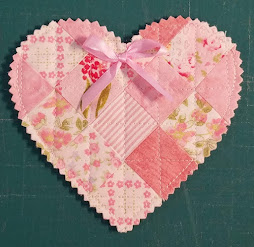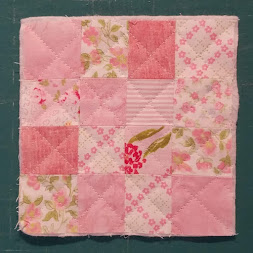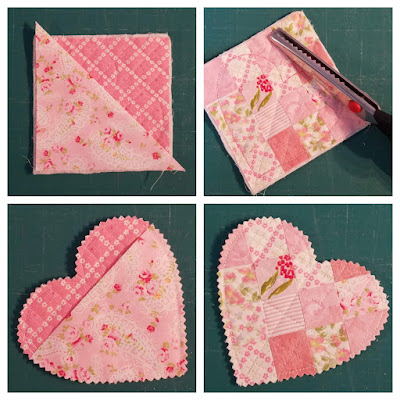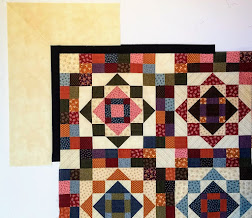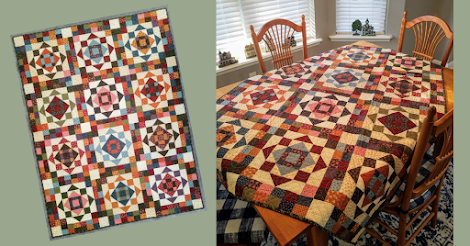You don't need anything special for this project, although I do love my pinking shears for finishing off a raw edge. If you have a pair, pull them out and dust them off. You are going to appreciate having them.
Other than the fabrics and optional trims, you will only need a sheet of paper and your basic quilting supplies.
Step 1 is to make a small piece of patchwork that measures 4 1/2", raw edge to raw edge. I chose to cut 1 1/2" squares. To make the block I needed 16 squares. I stitched them together in four rows of 4 squares each in random order. You could create a checkerboard pattern using only 2 fabrics. You could use random size strips instead of squares. The goal is to ENJOY the process. I think that helps build the love into this project.
The next step is to layer the patchwork block with a thin layer of batting and backing. A 5" square is perfect for the backing. It should be face-down with the batting on top and then the patchwork face-up on top of the batting to create your mini quilt sandwich.
Now you are ready to quilt! This is an important step. It is the details that you put into a project that take it from being something that has that "dorky homemade" look to being a gift with special meaning.
I did some simple crosshatch quilting by stitching diagonally corner-to-corner through the squares. Keep in mind that the squares on the outside edge have 1/4" seam allowance remaining, so the true corner of the square is NOT the edge of the fabric. It is 1/4" inside that edge.
I use my walking foot for the quilting, but this piece is so small that you won't need to. Give the quilt sandwich a quick press with your steam iron and the layers will cling together for you.
Now you can create your heart template. You learned to do this in kindergarten. Start with a 4" square of paper. Fold it in half diagonally. Starting at the folded edge, cut a half of a heart shape using your paper scissors. Unfold. TA DA! If you hate it, cut another one. Use the entire piece of paper to make your heart. It should measure a tiny bit less than 4".
Using your removable fabric marking pencil, draw your heart shape on the patchwork side of your heart. You should have approximately 1/4" of fabric extending on all sides. I use a Frixion pen that disappears with heat.
To finish this as a simple heart, top-stitch on the heart outline and then trim. This is where I use my pinking shears to create a cute edge. If you don't have pinking shears, you can simply trim approximately 1/4" from the stitching line.
I like to add a pocket to the back of the heart so that I can tuck in a note or gift card. To add the pocket, fold a 5" square in half diagonally with the right side showing. Place the folded piece on the back of the quilted patchwork, having the raw edges even. Check to make sure that the pocket is at the pointed end of the heart and that the folded edge is at lease1/4" below the "V" in the heart. Then stitch on the heart outline. The outline stitch will secure your pocket in place. Trim with pinking shears through all layers.
Add a simple bow by tacking the ribbon in place and then tying the bow. Trim the ends. If you plan to add beads or buttons by machine, add those to the patchwork layer before adding the pocket or you will stitch the pocket closed! Remember to keep any hard embellishments well away from the machine stitching line.
There is nothing left to do but give your heart away to someone you love!

